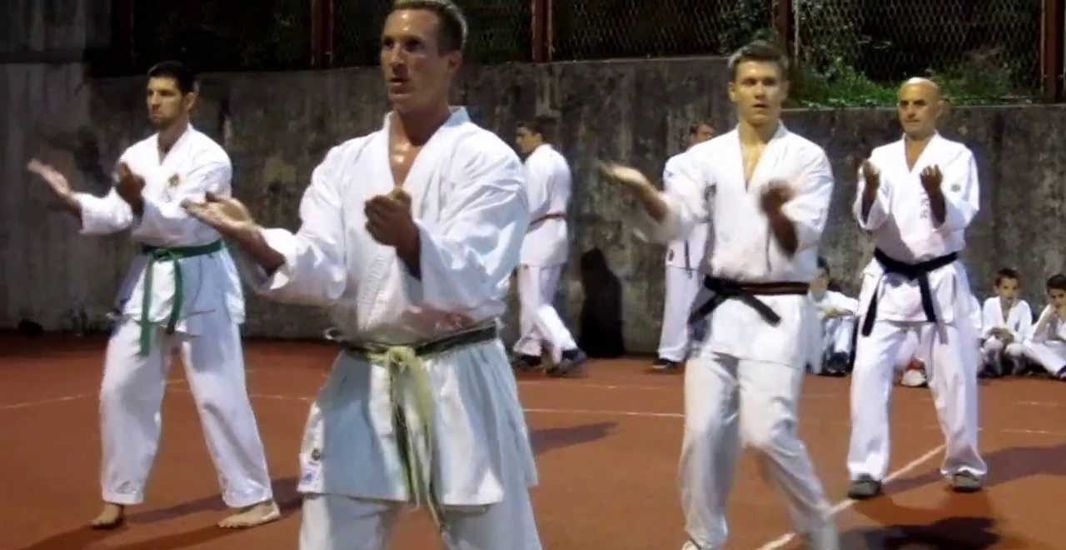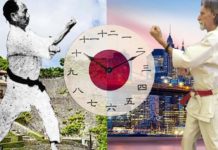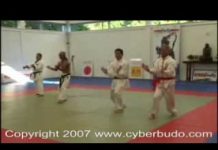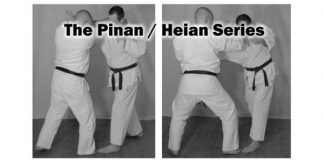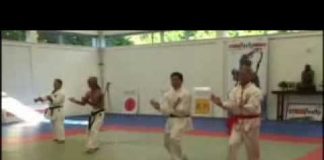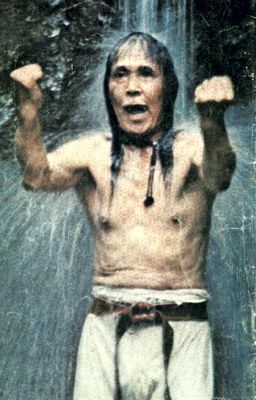 Kata (exercises or forms) are performed in many styles of martial arts. With the help of these particular forms of exercise, many diverse techniques are practiced.
Kata (exercises or forms) are performed in many styles of martial arts. With the help of these particular forms of exercise, many diverse techniques are practiced.
According to some sources, it is assumed that there are more than 400 different katas in the world today, performed in many diverse styles of martial arts. However, if we are to single out one kata that is special in its form and significance, it would surely be the Sanchin kata.
The Sanchin kata differs from all the rest by its use and representation in various styles of martial arts. For example, the Sanchin kata’s use can be found in martial arts such as Karate and Kung Fu, although its influence is seen in other Asian martial arts.
It is believed that the Sanchin kata appeared around the year 530 in the Shaolin temple, that it is 1500 years old and that its creator was the monk Bodidharma. It was created as a sort of a universal system of basic fighting exercise, but also a form of a physical exercise. According to a legend as well as certain foreknowledge, it is thought that the original name of the practice was 18 hand movements. Since the time it has originated until today, the practice was transmitted from one generation to another by various martial arts masters that have preserved it until today.
If we want to gain knowledge about its origin, especially because it is one of the oldest, if not the oldest katas ever to exist, its performance in various styles of martial arts should be examined.
Let’s start from the beginning.
The name Sanchin (Sanchin (サンチン) can be divided into two Chinese words- “san, 三“ which means three and “chin, 戦“ which means battle, i.e. a form of a conflict or war. The name of the this kata is usually translated as “three conflicts“ although the kata is also known under the translation “meditation in movement“. If we are talking about three conflicts, it is usually assumed that they are referred to the conflicts of the mind, body and spirit, i.e. a specific human quality which connects the mind with the body.
The kata is most popular in karate under the name sanchin, but the same kata has a number of other names. For example, in China (in many Kung Fu variations) “san chin“ is in the Cantonese dialect also existing as “saam jin“ and in the Mandarin dialect it is called “san chan“ or “san chien“ (七步三战) in the Fukien dialect. This kata is also known under the Chinese names of “sam chian“, “san chiem“ or the most well- known kung fu names “san zhan“ or “zach zhan“.
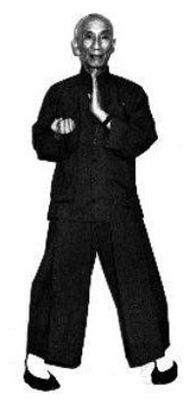 What makes this kata stand out from all the other katas is an unbelievable large number of style in which it is practiced. This is why the kata Sanchin is often seen in Karate styles such as Goyu Ryu, Uechi Ryu, Shito Ryu, Isshin Ryu, Kyokushinkai, Chito ryu, Kobayashi ryu, Shorin Ryu, Sankukai (Nanbu) Ryu, Shohei Ryu and Kobudo, but also in Kung Fu styles such as Five ancestors, Shaolin nam pai chuan, Fuijan white crane, Tiger crane, Pangai noon (Uechi Ryu), Ngo Cho Kun. Its influence is also seen in Emei snake, Dragon style, Hung gar, Tang lang, Goh chor, Lohan boxing, Wing tsun and Jeet Kune Do styles. The influence of the Sanchin kata is seen in many other different styles of martial arts so specific parts of Sanchin kata are inserted in many other katas of different styles. This way parts of the Sanchin kata can be seen in Seisan katas (13 hands), Sesan, Sisochin, Aragaki No Seisan, Jusan, Ken Shin Kan,Noi Khi Cong, Paporen, Suparimpe, Sanseru and Kururunpa kata and its influence can be greatly seen in Shotokan kata Hangetsu (the half moon position of the leg), as well as some Korean styles such as Tang Soo Do and Soo Bahk Do under the name of Sei Shan form. According to some foreknowledge, the master of karate Anko Itosu (1831-1915) is responsible for the insertion of the Sanchin kata into other karate katas. In order to minimize the Chinese influence, he wanted the Karate katas to have a Japanese name.
What makes this kata stand out from all the other katas is an unbelievable large number of style in which it is practiced. This is why the kata Sanchin is often seen in Karate styles such as Goyu Ryu, Uechi Ryu, Shito Ryu, Isshin Ryu, Kyokushinkai, Chito ryu, Kobayashi ryu, Shorin Ryu, Sankukai (Nanbu) Ryu, Shohei Ryu and Kobudo, but also in Kung Fu styles such as Five ancestors, Shaolin nam pai chuan, Fuijan white crane, Tiger crane, Pangai noon (Uechi Ryu), Ngo Cho Kun. Its influence is also seen in Emei snake, Dragon style, Hung gar, Tang lang, Goh chor, Lohan boxing, Wing tsun and Jeet Kune Do styles. The influence of the Sanchin kata is seen in many other different styles of martial arts so specific parts of Sanchin kata are inserted in many other katas of different styles. This way parts of the Sanchin kata can be seen in Seisan katas (13 hands), Sesan, Sisochin, Aragaki No Seisan, Jusan, Ken Shin Kan,Noi Khi Cong, Paporen, Suparimpe, Sanseru and Kururunpa kata and its influence can be greatly seen in Shotokan kata Hangetsu (the half moon position of the leg), as well as some Korean styles such as Tang Soo Do and Soo Bahk Do under the name of Sei Shan form. According to some foreknowledge, the master of karate Anko Itosu (1831-1915) is responsible for the insertion of the Sanchin kata into other karate katas. In order to minimize the Chinese influence, he wanted the Karate katas to have a Japanese name.
Sanchin is a kata that is primarily used to exercise the correct breathing technique and, with the help of certain martial arts and defensive techniques, the correct contraction of musculature.Technically speaking, it is very simple, but to correctly learn and use its elements is truly difficult. One of the reasons lies in the fact that, while performing the kata in karate, its movements are performed in complete tension (isometric training).
A person that is very patient and persistent can correctly perform the kata and this is the reason why some younger gymnasts avoid it, not having enough patience for it. For them the kata seems too slow and not active enough, without high foot punches, without jumps, without fast movements or certain gymnastic elements. We can simply say that they do not understand the elementary purpose of the performance of the kata. The fact that the Sanchin kata used to be performed on Okinawa in a period from 18 months until up to two years says enough about its importance. Today, it is learnt for about four months and sometimes even a lot shorter. This is the reason why its performance is often incorrect.
The basic elements that we gain by exercising the Sanchin kata are a correct and firm posture, correct movements by maintaining excellent balance, a good contraction and release as well as a perfect synchronization of the musculature, an excellent breathing control and a special exercize for mental concentration.
The Sanchin kata is, simply said, firstly done as a breathing exercize, but its performance and technique vary according to the style of use. Having this in mind, it can be noticed how karate practitioners, while performing a foot stance, place the front foot slightly bent towards inside and the whole stance is not too wide in order to maintain balance. Also, the weight of the practitioner is evenly distributed on both legs. This particular stance is called Sanchin Dachi, i.e. Sanchin stance. In various Kung Fu styles this foot positioning is more widely placed, i.e. while performing the kata the step is wider and the posture of the practitioner seems softer and more relaxed. The front leg is not so bent towards inside and its centre of gravity, i.e. the body’s mass is placed more towards the toes.
In all Kung Fu styles, the kata is significantly longer than in Karate styles. The reason for this lies in the fact that the Sanchin kata is in Karate divided into two parts- under the name Sanchin it is performed as one part of a kata, while the other part of the kata is performed under the name Tensho kata. Just like Sanchin kata, Tensho kata is basically a breathing kata. However, if we were to follow the historical development of the Sanchin kata, we would discover how the Tensho kata is its certain continuation, i.e. they are both a part of one kata which were, as time passed by, divided into two parts and are performed under two different names. Because of this, some masters of karate used to connect these two katas while performing them, such as the famous master of the Goyu Ryu style Gogen “The Cat“ Yamaguchi (1909 – 1989).
The Sanchin kata is in almost all styles of Kung Fu performed with opened palms, while in various Karate styles this kata is performed with clenched fists (closed fist). An exemption is the Uechi Ryu style in which the kata is performed with opened palms called Nukite – Zuki (open spear hand). Although certain variations in the performance of the kata in Karate as well as some Kung Fu styles exists, it is confirmed that it was originally performed with opened palms (open spear hand).
Also, the breathing technique while performing the kata varies across styles. In Karate the breathing is deeper, slower and oriented towards the abdomen (Ibuki), while in Kung Fu styles the breathing is much faster and more shallow. Certain deviations in the breathing technique exist the same way as in Karate styles and Kung Fu styles. Also, minor but also visible variations in breathing techniques exist even among masters of a certain style which depends on the person. Every master will alter a certain style and breathing technique to his own needs.
The basic technique (bunkai) found in Sanchin kata, i.e. the specific technique of blocking and performing punches is almost identical in all styles. Although some blocks or some postures may vary, it is basically the same technique which is performed in a bit modified way. Of course, this depends on the style. When blocking the opponent’s punches, circular blocks are primarily used (Va – uke). Whether there are smaller or bigger deviations from the basic technique, which greatly depends on the style, a mindful observer will immediately realize that it is the same technique and the same kata – Sanchin kata.
According to some folk tales the master Kanryo Higashionna (1853-1915) transmitted the knowledge about the Sanchin kata as well as its practice in various stlyes of Karate in Japan. He also transmitted the Sanchin kata from China to Okinawa although people knew about some of its exercizes much earlier. Today even two variations of the Sanchin kata are performed in the Goyu Ryu style of Karate. The first one is Sanchin Dai Ni (created by Higashionna) and the second one is Sanchin Dai Ichi (created by Miyagi).
The Sanchin kata is so important in the practice of martial arts that some of the greatest masters emphasized its importance and the need to exercize it regularly. Among a great number of masters the ones that need to be highlighted are certainly master Gogen “The Cat“ Yamaguci, Kanei Uechi (1911 – 1991), Masutatsu Oyama (1923 – 1994), Morio Higaonna, Tatsuo Shimabuku, Goshi Yamaguchi and many more. One of the most famous Karate masters, Choyun Miyagi (1888 – 1953), a master of the Goju Ryu style, often talked how the Sanchin kata should be practiced thirty times in one day, emphasizing its importance for the human body.
The significance and the impact of the Sanchin kata on the body was recognized long ago- However, a group of masters of the Isshin Ryu style headed by dr. Kevin Seufert have carried out a research in the Navy Hospital sports medicine clinic in Pendleton about its effect on the human body in 1997. While performing the kata supervised by the Karate master Norm Losier and measuring their pulses, blood pressure and running an ECG, they came to the conclusion that the kata doesn’t have any harmful effects of the health, but they haven’t found out how beneficial it really is for the body. Although this research is praiseworthy, it didn’t show us how important is the transport of oxygen to the human body and how important is its transmission through blood and its supply to the muscles. Also, it didn’t reveal how big is the impact of the kata on the internal organs, how much it improves the lung capacity, the growth of mental abilities and certain stability of the gymnast. The research didn’t snow how the practice effects the proper contraction and relaxation of the musculature, in what amount is it connected with the so- called Ki (Chi) bodily energy as well as many more unanswered questions. Whether we possess certain awareness that the Sanchin kata, as an exercise, influenced the development of the famous Chinese skill Tai Chi, especially the Sun style, then we can assume that the kata has a great therapeutic value.
Although the connection among various styles of Kung Fu and Karate are known from the early beginnings of exercise, an event called Budosai held in Great Britain in 2007 united four masters of different style of Karate and Kung Fu and looked at their performance of the Sanchin kata. Those were masters Pan Yong Chun, a master of the White crane style, Chien Jian Feng, a master of the Wu Shu Guan style, Shinyu Gushi, a master of the Uechi Ryu (Pangai Noon) style and Morio Higaonna, a master of the Goyu Ryu style of martial arts.
The Sanchin kata can be practiced in different ways, which depends on the style and the skill, i.e. mastership of the gymnast who performs it. There are gymnasts who perform the kata by wearing metal bracelets around their hands, by holding weighs, by tying their hands alongside their body, by practicing it on the snow during Winter or on the sand during Summer. Parts of the kata can be performed in a way that gymnasts hold certain weighs, jars or a heavy object in their hands (for example, a big rock). The kata may be performed under a waterfall which has a unique effect on concentration and the breathing technique. Also, the kata may be practiced so that the gymnast is immersed into water neck- high (in the sea, river or a pool). The water can be of a different temperature, depending on the gymnasts’s wish and ability,spanning from very cold to lukewarm.
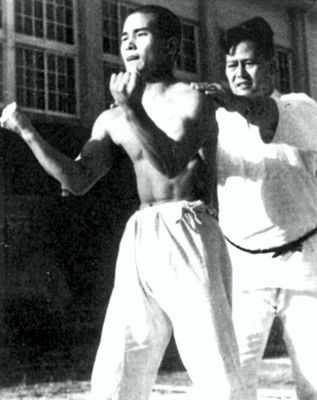 It can be often seen in various Karate style how the gymnast is tested in a specific way while performing the Sanchin kata. An instructor may stand near the gymnast and check the firmness of his posture, the correct muscle tone, his correct breathing and movement. The older master- instructor tests the gymnast in a way that he hits his body (Shime) on certain places and in a certain way as well as checks his muscle tone by a certain touch. A similar testing can be found in some styles of Kung Fu called Chi Kong. Unfortunately, some gymnasts exaggerate with this test and this type of checking, thinking that the gymnast who can bear the strongest hits is the best practitioner of the kata. There is no special reason for this because this may or may not be the case in practicing the Sanchin kata. Every gymnast can, according to his wish, test his own performance of the kata. The only important thing is that the kata is practices correctly. The Sanchin kata can be, as opposed to some other katas, exercised from a very young to a very old age in life.
It can be often seen in various Karate style how the gymnast is tested in a specific way while performing the Sanchin kata. An instructor may stand near the gymnast and check the firmness of his posture, the correct muscle tone, his correct breathing and movement. The older master- instructor tests the gymnast in a way that he hits his body (Shime) on certain places and in a certain way as well as checks his muscle tone by a certain touch. A similar testing can be found in some styles of Kung Fu called Chi Kong. Unfortunately, some gymnasts exaggerate with this test and this type of checking, thinking that the gymnast who can bear the strongest hits is the best practitioner of the kata. There is no special reason for this because this may or may not be the case in practicing the Sanchin kata. Every gymnast can, according to his wish, test his own performance of the kata. The only important thing is that the kata is practices correctly. The Sanchin kata can be, as opposed to some other katas, exercised from a very young to a very old age in life.
As much as we think that we know a lot about the Sanchin kata today or that we have found out all of its secrets, the truth is entirely different. Every man who lightly and not thoroughly practices the Sanchin kata will now perceive all of its beauty as well as the importance of its exercise. If we perform the kata incorrectly, its effectiveness will be absent.
As soon as you have started thinking about correct breathing as well as its importance for your body, you have already profited.
This is exactly why the Sanchin kata is the basis for all the other katas.

